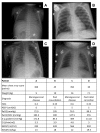Extravascular lung water index measurement in critically ill children does not correlate with a chest x-ray score of pulmonary edema
- PMID: 20529308
- PMCID: PMC2911751
- DOI: 10.1186/cc9054
Extravascular lung water index measurement in critically ill children does not correlate with a chest x-ray score of pulmonary edema
Erratum in
- Crit Care. 2010;14(4):430
Abstract
Introduction: Extravascular lung water index (EVLWI) can be measured at the bedside using the transpulmonary thermodilution technique (TPTD). The goal of this study was to compare EVLWI values with a chest x-ray score of pulmonary edema and markers of oxygenation in critically ill children.
Methods: This was a prospective observational study in a pediatric intensive care unit of a university hospital. We included 27 critically ill children with an indication for advanced invasive hemodynamic monitoring. No specific interventions for the purpose of the study were carried out. Measurements included EVLWI and other relevant hemodynamic variables. Blood gas analysis, ventilator parameters, chest x-ray and TPTD measurements were obtained within a three-hour time frame. Two radiologists assessed the chest x-ray and determined a score for pulmonary edema.
Results: A total of 103 measurements from 24 patients were eligible for final analysis. Mean age was two years (range: two months to eight years). Median cardiac index was 4.00 (range: 1.65 to 10.85) l/min/m2. Median EVLWI was 16 (range: 6 to 31) ml/kg. The weighted kappa between the chest x-ray scores of the two radiologists was 0.53. There was no significant correlation between EVLWI or chest x-ray score and the number of ventilator days, severity of illness or markers of oxygenation. There was no correlation between EVLWI and the chest x-ray score. EVLWI was significantly correlated with age and length (r2 of 0.47 and 0.67 respectively).
Conclusions: The extravascular lung water index in critically ill children does not correlate with a chest x-ray score of pulmonary edema, nor with markers of oxygenation.
Figures
Comment in
-
Assessing the quantity of pulmonary edema in critically ill children.Crit Care. 2010;14(4):189. doi: 10.1186/cc9199. Epub 2010 Aug 13. Crit Care. 2010. PMID: 20804574 Free PMC article.
Similar articles
-
Computed tomography to estimate cardiac preload and extravascular lung water. A retrospective analysis in critically ill patients.Scand J Trauma Resusc Emerg Med. 2011 May 23;19:31. doi: 10.1186/1757-7241-19-31. Scand J Trauma Resusc Emerg Med. 2011. PMID: 21605380 Free PMC article.
-
Quantitative computed tomography in comparison with transpulmonary thermodilution for the estimation of pulmonary fluid status: a clinical study in critically ill patients.J Clin Monit Comput. 2019 Feb;33(1):5-12. doi: 10.1007/s10877-018-0144-1. Epub 2018 Apr 21. J Clin Monit Comput. 2019. PMID: 29680878
-
B-Lines Scores Derived From Lung Ultrasound Provide Accurate Prediction of Extravascular Lung Water Index: An Observational Study in Critically Ill Patients.J Intensive Care Med. 2022 Jan;37(1):21-31. doi: 10.1177/0885066620967655. Epub 2020 Nov 5. J Intensive Care Med. 2022. PMID: 33148110 Free PMC article.
-
Transpulmonary Thermodilution: Its Role in Assessment of Lung Water and Pulmonary Edema.J Cardiothorac Vasc Anesth. 2017 Aug;31(4):1471-1480. doi: 10.1053/j.jvca.2017.02.018. Epub 2017 Feb 4. J Cardiothorac Vasc Anesth. 2017. PMID: 28465120 Review.
-
Assessment of Pulmonary Edema: Principles and Practice.J Cardiothorac Vasc Anesth. 2018 Apr;32(2):901-914. doi: 10.1053/j.jvca.2017.08.028. Epub 2017 Aug 19. J Cardiothorac Vasc Anesth. 2018. PMID: 29174750 Review.
Cited by
-
Assessing the quantity of pulmonary edema in critically ill children.Crit Care. 2010;14(4):189. doi: 10.1186/cc9199. Epub 2010 Aug 13. Crit Care. 2010. PMID: 20804574 Free PMC article.
-
A deep learning model enables accurate prediction and quantification of pulmonary edema from chest X-rays.Crit Care. 2023 May 26;27(1):201. doi: 10.1186/s13054-023-04426-5. Crit Care. 2023. PMID: 37237287 Free PMC article.
-
Year in review 2010: Critical Care--Cardiology.Crit Care. 2011;15(6):241. doi: 10.1186/cc10542. Epub 2011 Dec 5. Crit Care. 2011. PMID: 22152086 Free PMC article. Review.
-
Estimation of extravascular lung water using the transpulmonary ultrasound dilution (TPUD) method: a validation study in neonatal lambs.J Clin Monit Comput. 2016 Dec;30(6):985-994. doi: 10.1007/s10877-015-9803-7. Epub 2015 Nov 12. J Clin Monit Comput. 2016. PMID: 26563187 Free PMC article.
-
Propranolol Reduces Cardiac Index But does not Adversely Affect Peripheral Perfusion in Severely Burned Children.Shock. 2016 Nov;46(5):486-491. doi: 10.1097/SHK.0000000000000671. Shock. 2016. PMID: 27380530 Free PMC article. Clinical Trial.
References
-
- Cecchetti C, Lubrano R, Cristaldi S, Stoppa F, Barbieri MA, Elli M, Masciangelo R, Perrotta D, Travasso E, Raggi C, Marano M, Pirozzi N. Relationship between global end-diastolic volume and cardiac output in critically ill infants and children. Crit Care Med. 2008;36:928–932. - PubMed
-
- Phillips CR, Chesnutt MS, Smith SM. Extravascular lung water in sepsis-associated acute respiratory distress syndrome: Indexing with predicted body weight improves correlation with severity of illness and survival. Crit Care Med. 2008;36:69–73. doi: 10.1097/01.CCM.0000295314.01232.BE. - DOI - PubMed
Publication types
MeSH terms
LinkOut - more resources
Full Text Sources




